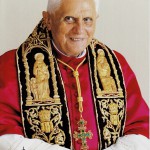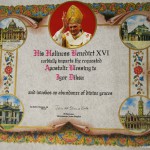His Holiness Pope Benedict XVI
His Holiness Pope Benedict XVI (secular name Joseph Aloisius Ratzinger) is the 265th successor of Apostle Peter as Pope of Rome.
The Pope’s official title — His Holiness Pope Benedict XVI, Bishop of Rome.
Joseph Aloisius Ratzinger was born on April 16 of 1927 in a little village Marktle am Inn in Bavaria in a family of a police officer. He was the third and youngest child in the family of a rural policeman Joseph Ratzinger and Mary Ratzinger. When he was two years old, his family moved to the Austrian border; and in 1932 – to the Alpine village of Auschau. Ratzinger’s father, who did not approve of national-socialism, gave his son to the Gymnasium for classical languages in Traunstein in 1937.
In 1939, the future cardinal became a student of a minor seminary, thus, starting his church career. During the war, young Joseph was a member of German youth anti-aircraft corps, at the same time attending classes in Ludwig-Maximilian University in Munich. In 1941, he was enrolled in the Hitler Youth, as membership was legally required for German boys who turned 14 years old beginning from 1939. When he came of drafting age in 1944, he was drafted to the Austrian Legion. Ratzinger himself spoke of this time with contempt as of an ideological brainwash. He participated in the military drill of Wehrmacht, but soon was released due to poor health condition.
In 1945, he deserted from Wehrmacht as the allied forces were approaching; then the future cardinal returned back home to Traunstein. When the American troops were stationed in his village, their headquarters lodged in the Ratziger’s house. Joseph was identified as a soldier; he was arrested and put in a camp for the prisoners of war. But very soon – in June, Ratziger came back home; and in November he returned to the seminary.
In 1947, Ratziger entered the Ducal Georgianum, a theological institute associated with the University of Munich. On June 29 of 1951, on the Holy day of St Peter and Paul, Joseph Ratziger and his brother Georg were ordained as priests by Cardinal Michael von Faulhaber in Freising. In 1953, Ratziger defended his dissertation on theology in the University of Munich. His work was entitled The People and the House of God in Augustine’s Doctrine of the Church. His habilitation was devoted to the theology of history in the works of St Bonaventure.
On April 15 of 1959, Ratziger received the professorial position and cathedra of main theology at the University of Bonn. The same year his father died. In 1962-1965, during four sessions of the Second Vatican Council, Ratziger was present there as a consultant (peritus) to Cardinal Joseph Frings of Cologne.
Meanwhile, the academic career of Joseph Ratziger made a turn. In 1963, (the year of his mother’s death) he transferred to the University of Münster, and in 1966 he was appointed to a chair in dogmatic theology at the University of Tübingen. His appointment was actively supported by liberal theologian and Professor Hans Küng.
In 1968, during student riots, Tübingen theological school was domineered by Marxist influences. Professor Ratziger spoke strongly against the “instrumentalization by ideologies that were tyrannical.” In 1969, Ratziger’s conflict with liberal theologians of Tübingen forced him to leave the university and come back to Bavaria and take a teaching position at the University of Regensburg. He eventually became dean and vice president and later, chief theological advisor to all German bishops.
In 1972, Joseph Ratzinger together with Hans Urs von Balthasar, Henry De Lubac and others launched the Catholic theological journal Communio (Communion) devoted to questions of theology and culture. On March 24 of 1977, Ratzinger was appointed Archbishop of Munich and Freising, in spite of his own unwillingness. For his Episcopal motto, he chose the words from the Third Epistle of John, Coworker of the Truth. In his memoirs Ratziger says, that he wanted to connect his previous work as teacher and his new mission by this motto. Besides, he thought that in the world of today the matter of the truth had become as crucial as ever.
The ceremony of his consecration took place on May the 28th, and as early as on June the 27th of 1977, Pope Paul IV elevated him to Cardinal’s status. In 1980, Pope John Paul II appointed cardinal Ratziger to chair the special Synod on the Laity. Later, he offered him to head up the Congregation for Catholic Education. This appointment required him to leave Munich’s cathedra and move to Vatican. Originally, Ratziger declined the Pope’s proposal, but on November 25 of 1981, he made the decision to take over as Prefect of the Congregation for the Doctrine of the Faith. At the sane time, he dropped his Episcopal responsibilities in Germany and moved to Vatican. In Vatican he became a regular participant of Episcopal Synods, and in 1993, he accepted the title of the Bishop of Velletri-Segni, the suburb of Rome. In 2000, the future Pope became the Dean of the College of Cardinals, and his title from then on was the Bishop of Ostia and Velletri-Segni.
After the death of Pope John Paul II on April 2 of 2005, Joseph Ratziger was elected by the Conclave of Cardinals to be the new Pope on April 19 of 2005. Joseph Ratziger accepted the pontifical name Benedict XVI (Benedictus), meaning “the blessed,” in honour of both Pope Benedict XV (1854—1922) and Saint Benedict of Nursia (480—547). On April 24 of 2005, Benedict XVI celebrated the Papal Inauguration Mass in St. Peter’s Square, where he received the Pallium and the Ring of the Fisherman (Anulus Piscatoris, in Latin). On May 7 of the same year, Benedict took possession of the cathedra of the Bishop of Rome in the Archbasilica of St. John Lateran.
Numerous works belong to the pen of Joseph Ratzinger, such as A turning Point for Europe?; Truth and Tolerance; God Is Near Us; Called to Communion; God and the World; Ministers of Your Joy; A New Song for the Lord; Introduction to Christianity and so forth. In theological discussions Cardinal Ratziger stood on conservative grounds; he was the chief consultant on theology for Pope John Paul II. Cardinal Ratziger is a member of the Ecclesia Dei Committee (it unites conservative clergy, which did not receive liturgical reforms of the Second Vatican council, but remained in submission to the Papal throne), and, virtually, the major theologian in Vatican. His position concerning a number of matters became the official position of Vatican. For example, he stood for the papal primacy, value of life and unacceptability of abortions; he also spoke concerning a great number of other theological questions.
Benedict XVI was the oldest person to have been elected Pope since Pope Clement XII (elected in 1730). Benedict XVI was the first Dean of the College elected Pope since Paul IV (XVI century), the first cardinal bishop elected Pope since Pius VIII, the first Pope since Benedict XIII, who held the title of cardinal for a very long time (28 years) before being elected as Pope, and the first German Pope for over one thousand years. He is one of the oldest current state leaders in the world.
Pope Benedict XVI fluently speaks German, Italian, Latin, English and Spanish. He can read texts in Old Greek and Hebrew.



